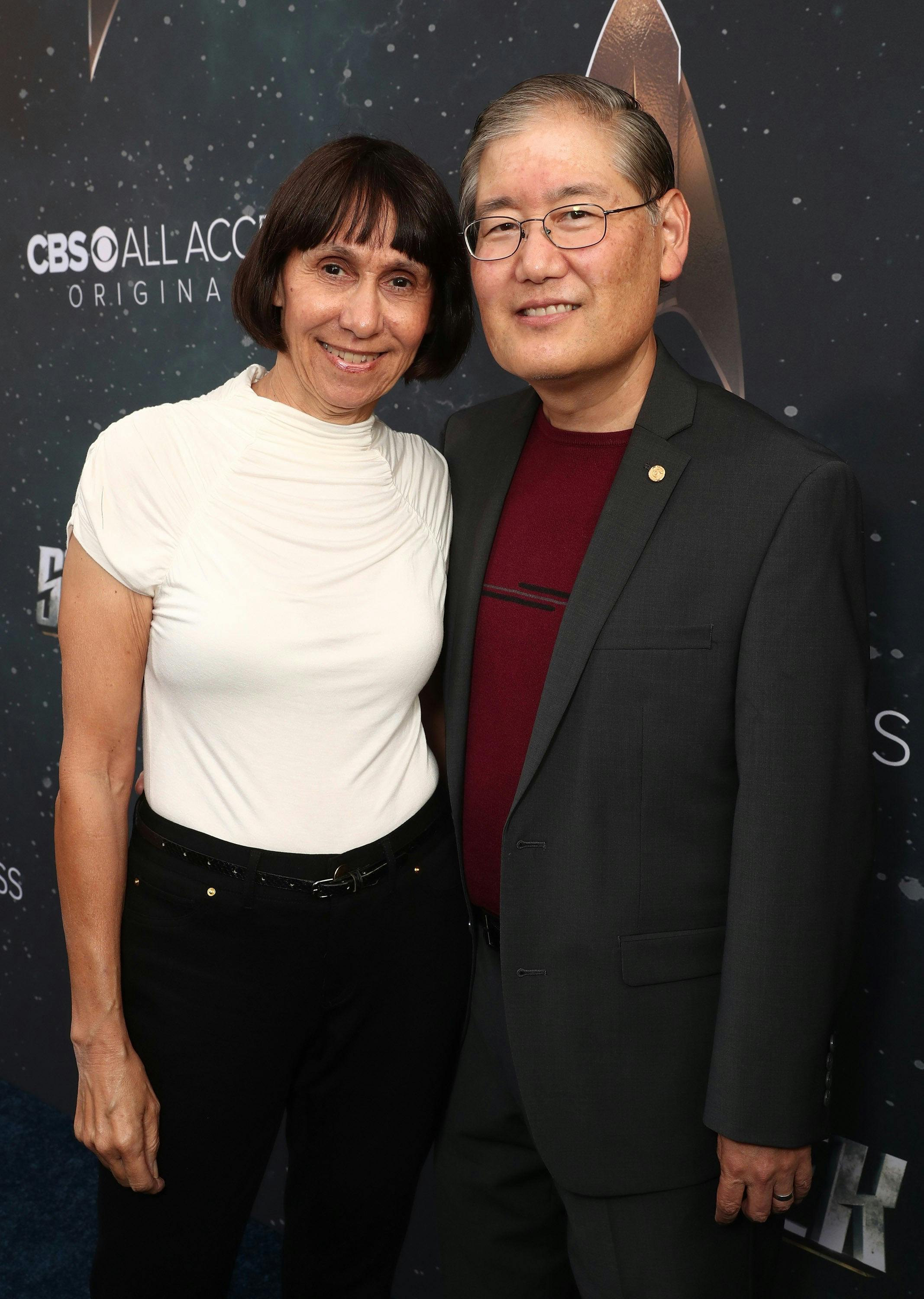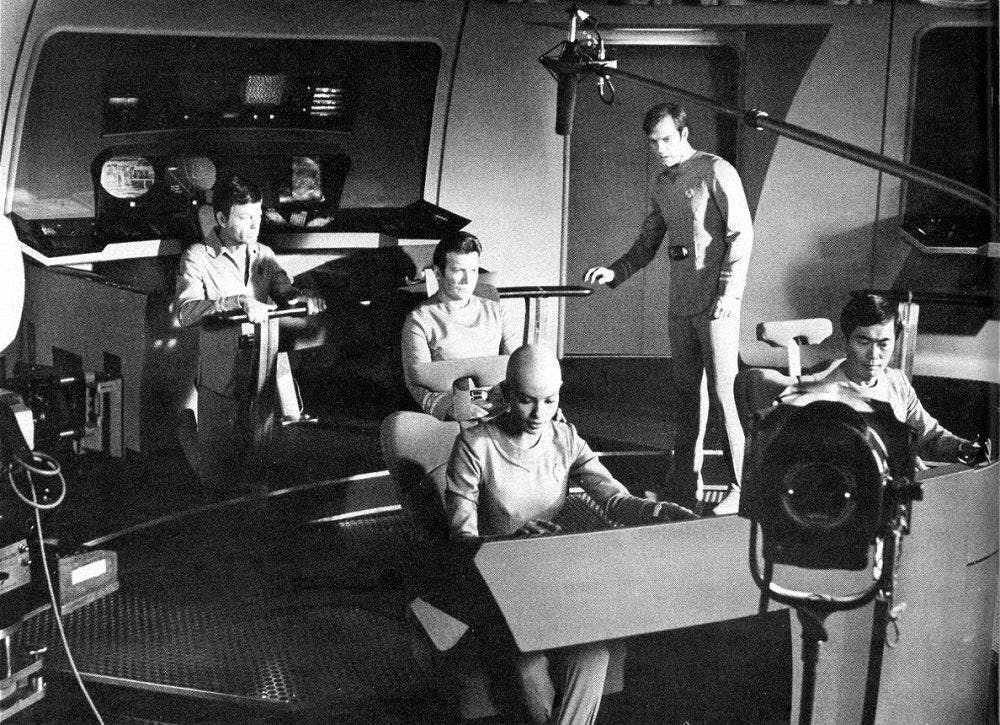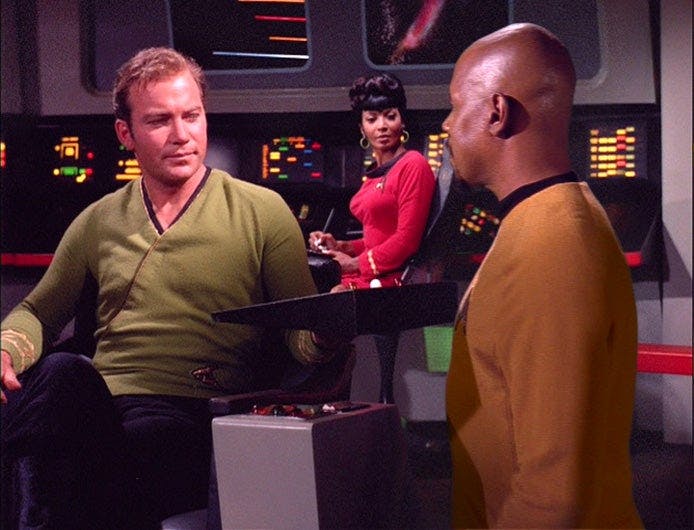Published Aug 6, 2022
Star Trek Archeology with Michael and Denise Okuda
The longtime Trek production duo detail how many Star Trek sets were built one on top of the other.

StarTrek.com
Michael Okuda and Denise Okuda are Star Trek production royalty. They worked on every incarnation of Trek, on both the small and big screens, from the late 1980s through to Enterprise in 2005. They’ve also authored many of Trek’s most seminal behind-the-scenes texts, including The Star Trek Encyclopedia and The Star Trek: The Next Generation Technical Manual. Since 2005, the Okudas have been involved in a wide variety of Trek-related projects (including the HD Remastering of Star Trek: The Original Series and Star Trek: The Next Generation).
Ever since I was a kid, I’ve always been fascinated by the behind-the-scenes aspects of Star Trek. Like many fans, I consumed every ‘making-of’ book, documentary, interview, and article I could get my hands on. While what ends up on-screen is the endgame, I love learning about the journey, and at times, the Herculean effort, an episode, film, or series took from initial idea to final product.
One thing many of us who deep dive into the episode process have noticed is just how Star Trek sets, props, and costumes are used and reused by different productions — a practice that originated in TOS and continues to this day (the Bridge of Captain Riker’s U.S.S. Zheng He in Star Trek: Picard is a redress of the Discovery’s Bridge).
Recently, while listening to Mike and Denise Okuda wax lyrically on one of the Star Trek: The Motion Picture audio commentaries, they mentioned something that made my ears perk up — many Star Trek sets were built one on top of the other. When you worked on the sets, you could quite literally see the history of Star Trek in between walls and video screens — they called it a form of ‘Star Trek Archaeology.’

Getty Images
Even with all of the commentaries they’ve recorded, pieces they’ve written, and interviews given, I still found myself with questions. This concept of ‘Star Trek Archaeology’ (which, with the brief addition of a colon, totally sounds like the title of a future series) was so fascinating that I contacted Mike and Denise to learn more.
StarTrek.com: You both have had long and diverse involvement with many iterations of Star Trek. How did you start at the franchise and what were your main jobs?
Denise Okuda: I was working as a registered nurse, not an artist. I had friends connected to the production, and I was asked to come and speak to people in the art department, as I had grown-up with Star Trek and was a huge fan, about what I saw as the Sick Bay of the future.
While I was there, I saw a figurine of Max Headroom, which I love, on someone's desk. I asked, ‘Whose desk is this?’ and it was Mike’s. We got to chatting, one thing led to another, and at a certain point, I started coming up to the studio on evenings and weekends to be with Mike. I was eventually hired as a production assistant. I was then hired by production designer Herman Zimmerman, and I became part of the graphics department, which Mike headed. I also became a video supervisor [where] I was responsible for all of the video playback on all the monitors and screens, mostly from Deep Space Nine onwards. We were working two television shows, and a feature every other year for a decade so it was a good thing we were married or we would never have seen each other!
Mike Okuda: I got started on Voyage Home. I grew up a big fan of the space program so it was a very short leap to becoming a Star Trek fan. After college, I started working in corporate graphics — logos, newsletters, and signage.
When I saw Star Trek: The Motion Picture, I noticed that they had these round screens on the Bridge. While I thought that was interesting and futuristic, the actual graphics inside the round screen were rectangular-based, which is not an efficient use of your screen space. I sketched something up for my own amusement. When I was done, I thought it was interesting; I put it all in an envelope and mailed it to Paramount Pictures. One day, I got a call from Ralph Winter, one of the producers of Star Trek III, who said that the stuff I had sent in was interesting. But they’re already staffed up on Star Trek III, but if they ever make a Star Trek IV, he’ll give me a call. I thought that was the nicest brush-off I’d ever get. Well to my great surprise, two years later, he called and said, ‘We’re making Star Trek IV, do you want to work on it?’ So that’s how I got my start in Star Trek.

StarTrek.com
StarTrek.com: Mike, did you go from Star Trek IV directly into The Next Generation?
Mike Okuda: After Star Trek IV was done sometime in the middle of 1986, I thought that was it — that was my big brush with Hollywood and I got to work on Star Trek. A couple of weeks prior to the release of Star Trek IV, Paramount announced that they would be making a new television series, The Next Generation. Around the same time, I was planning to go to Los Angeles – I was living in Hawaii [at the time] – to attend the cast and crew screening. At the cast and crew screening of Star Trek IV, I ran into Gene Roddenberry and he kindly remembered me. He asked me what I was going to do next. I had arranged to fly to the Bay Area and visit Industrial Light and Magic (ILM). I wanted to tour ILM; who wouldn’t? Gene, who knew exactly how to flatter someone said, 'Oh I hope that before you take a job there, you’d consider us?' And that led me to being hired on TNG.
StarTrek.com: In some detail, can you tell us what you did on the shows and how your roles evolved over the years? Mike Okuda: I was the lead graphic designer for all of those productions from TNG through Enterprise. Nowadays, when you look at science-fiction films, graphics are an accepted part of it. Back then, graphics were just someone designing signs and maybe some labels on control panels. They didn’t really think of graphics as a major design element. The downside to that [mindset] was our budgets were tiny. The upside was that nobody really knew what graphics could do for science-fiction television, so our producers pretty much left us alone. Within our very small production domain, we pretty much had free [rein] to do within the limits of our imagination and what we could afford. There was an episode of Enterprise, for example, where I decided to project some video graphics on top of a guy’s head and they would say 'OK, do that!'
Graphics became detailing on props, on models, then it became video animation for the screens, then it became video animation generated by computer for 24 frames for video playback on-set, then it became video graphics for post-production work. It came to encompass quite a lot!
Denise Okuda: Mike was the head of the graphics department and he had people working for him. He had a crew of graphic designers with the number varied depending if it was a series or a movie. Because we were fans of Star Trek and because Mike’s background came from making graphics with very little money, we were able to do a lot of work with very little. Fortunately, our bosses, Herman Zimmerman and Richard James, let us have freedom – and so we were able to do a lot of work and be cost effective.
Mike Okuda: No matter how small or big your budget is, you always want to do more than what your budget will allow. Star Trek VI was even more tightly budgeted than usual. We did not have the money for signage in the Enterprise, on the doors and such. I would literally go to the production office and I would take a ream of legal-sized blue paper and I would run that through the copy machines and that how I made the signage all over the ship. Nick Meyer loved that stuff.
Denise Okuda: [We] picked and committed to a look, and we went with that look which gave the universe a consistency and believability. That’s how we got around budget and the fact that we didn’t have the latest, greatest technology.Mike Okuda: We had arbitrarily said this is what our version of the 24th Century looks like based on what we thought looked cool and what we could do on time and within budget. We tried very hard to be internally consistent, which I think is one of the most important keys to believability.
StarTrek.com: In your audio commentary for Star Trek: The Motion Picture, you mentioned that some of the sets that were built for Star Trek:Phase II were still standing and built on for Voyager.
Mike Okuda: The important thing to understand is Star Trek is about the vastness of the cosmos, about a new planet, a new alien civilization every week — aboard this fabulous 23rd or 24th Century starship — but you have to do it on a television budget and schedule. How do you do this? Roddenberry designed the show to take place on the Bridge of the Enterprise. You have an expensive Control Room, but we see it a lot so the money you invest in that set is used over and over again. But when you go to another world, you design it as much as possible to use stock stuff, to reuse things and to stretch that production dollar because you don’t have the money or the time to do something from scratch every week, no matter your budget.

StarTrek.com
Denise Okuda: Many sets were built from each other, specifically from Wrath of Khan onwards. When they were taking down the engineering set at the end of Voyager to make room for Enterprise, I noticed different coloration underneath Voyager’s Engine Room. It turned out that they were the remnants of the Star Trek II engineering sets, which had been hiding there since 1978.
Mike Okuda: Most film and television sets have catwalks above them, lighting equipment and things hang above the set. The only people who are up there are the lightning personnel. While on Voyager, I snuck up above some sets, and you could see that outside the Voyager walls, we had the Star Trek: The Motion Picture corridors. And a few inches outside of that you had the straight walls of the Star Trek: Phase II corridors. It was very much Star Trek Archaeology. A lot of the time, you tear stuff down when you modify things, but in Trek’s case, many sets were done under such time pressure, you left things up and you just attached things to them!
Denise Okuda: The same thing with the Transporter Rooms. It all boil downs to time and money in production; they don’t care about anything that came before it. It’s all about how can we do this with the crunch schedule that we have and make it look cool.
Mike Okuda: Exactly. Two weeks before they were due to begin principal photography on Star Trek: Phase II[in the mid-1970s] they pulled the plug and announced that they would be making Star Trek: The Motion Picture instead. The Motion Picture had its roots in a script called “In Thy Image,” which was a Phase II script. A lot of creative decisions for sets were already made. When Robert Wise came in as director, he ordered a revamp to the Bridge and to the Engine Room. A lot of decisions had to be made within a very tight shooting schedule and they had to start shooting on this date and they could not start from scratch and so they had to do with what they had, [which was] why those corridors were built inside other ones. I remember on Star Trek IV, I crawled under the Bridge and found that some control panels, built for Phase II, had been torn out, tossed under the set, and replaced with the The Motion Picture control panels!
StarTrek.com: What are some of the most surprising or creative reuse of a set?
Mike Okuda: When we did Star Trek: Generations, Herman Zimmerman quite brilliantly turned the Enterprise-B bridge into the wrecked Armagosa Observatory. Also, in the first season of TNG, the Observation Lounge was a redress of Sick Bay.
StarTrek.com: Both of you have had amazing careers in Star Trek. What specific contributions are you most proud of?
Denise Okuda: We were both very proud of our contributions to the DS9 episode 'Trials and Tribble-ations.' We contributed a lot because we were so familiar with TOS. Everybody on the production gave 110% on that episode. Probably one of my proudest moments on Star Trek.

StarTrek.com
Mike Okuda: The overall use of graphics for the Enterprise-D on TNG partly because I think the designs are cool but also because up to that point, it wasn’t a common practice to use graphics as a major design element in quite the same fashion. Herman Zimmerman trusted me to make that part of the show look interesting and as result, I think I was able to really contribute to the visual identity of that era of Star Trek.
StarTrek.com: To wrap things up, what are you two working on now?
Mike Okuda: We’re working on a lot of things! We recently worked as graphics consultants on Netflix’s Space Force. Also, Clint Eastwood’s Richard Jewell, and Mark Altman’s Pandora.
Denise Okuda: We’re also working on Ron Moore’s For All Mankind on Apple TV+. We’re tech advisors on that one, and we get to hang out in Mission Control and work with the actors in their spaceships. It’s some of the most fun we’ve had since leaving Star Trek.
A big thank you to Mike and Denise Okuda for their time and stories. Make sure you follow Mike and Denise Okuda on Twitter: @MikeOkuda and @DeniseOkuda.
This interview has been edited and condensed.
This article was originally published on July 22, 2020.
Carlos Miranda (he/him) is the CEO of Social Misfits Media, a London-based digital agency. Carlos, as obsessed with coffee as he is sci-fi, loves blogging about Star Trek in his spare time. Follow him on Twitter: @doublemacc.
Stay tuned to StarTrek.com for more details! And be sure to follow @StarTrek on Facebook, Twitter, and Instagram.

